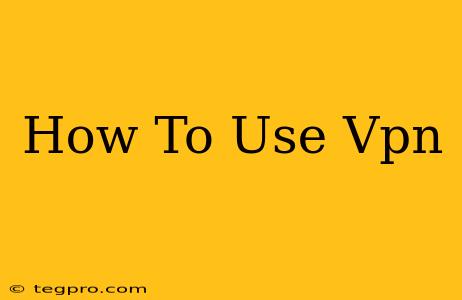Are you looking to enhance your online privacy and security? A Virtual Private Network (VPN) is a powerful tool that can help you achieve just that. This comprehensive guide will walk you through everything you need to know about how to use a VPN, from choosing the right provider to troubleshooting common issues.
What is a VPN and Why Should You Use One?
A VPN creates a secure, encrypted connection between your device and the internet. Think of it as a private tunnel shielding your online activity from prying eyes. This encryption masks your IP address, making it difficult for anyone to track your browsing history, location, or online activities.
Here's why you should consider using a VPN:
- Enhanced Privacy: Protect your personal data from hackers, ISPs, and government surveillance.
- Secure Public Wi-Fi: Safely access the internet on public Wi-Fi hotspots, preventing data breaches.
- Bypass Geo-Restrictions: Access websites and streaming services that are blocked in your region.
- Increased Security: Protect yourself from malware and phishing attacks.
- Anonymity: Browse the internet more anonymously, safeguarding your identity.
Choosing the Right VPN Provider
Selecting the right VPN provider is crucial for optimal performance and security. Consider these factors:
- Security Features: Look for strong encryption protocols (like OpenVPN or WireGuard), a strict no-logs policy, and advanced security features like a kill switch.
- Server Locations: Choose a provider with a wide network of servers in various locations to bypass geo-restrictions and optimize speed.
- Speed and Performance: A slow VPN can be frustrating. Read reviews and check user feedback on speed and performance.
- Customer Support: Ensure the provider offers reliable customer support in case you encounter any problems.
- Pricing and Plans: Compare pricing plans and choose one that fits your budget and needs.
How to Use a VPN: A Step-by-Step Guide
The exact steps may vary slightly depending on your chosen VPN provider and device, but the general process is similar:
1. Choose and Subscribe: Select a reputable VPN provider and subscribe to their service.
2. Download and Install: Download the VPN app for your device (Windows, macOS, Android, iOS, etc.) and install it.
3. Connect to a Server: Open the VPN app and select a server location. Choosing a server closer to your physical location generally results in faster speeds.
4. Verify Your Connection: Once connected, your IP address should change to reflect the server location you selected. Many VPN apps have a built-in feature to check this.
5. Browse Securely: Now you can browse the internet, stream content, or use other online services with increased privacy and security.
6. Disconnect When Finished: Remember to disconnect from the VPN when you're finished using it.
Troubleshooting Common VPN Issues
Here are some solutions to common VPN problems:
- Slow Speeds: Try connecting to a different server location or contacting your VPN provider for support.
- Connection Errors: Ensure your internet connection is stable and check the VPN app's settings for any errors.
- Website Access Issues: Try clearing your browser's cache and cookies, or try connecting to a different server.
Staying Safe Online with a VPN
Using a VPN is a proactive step towards enhancing your online safety and privacy. By understanding how to use a VPN effectively and choosing a reliable provider, you can enjoy a more secure and private online experience. Remember to stay informed about the latest online security threats and update your VPN software regularly. This will ensure you remain protected in the ever-evolving digital landscape.

